Why you can trust Tom's Hardware
The M32UC is a very color-accurate monitor in its default Green picture mode. Though confusingly termed, this mode is most definitely not green. It can be likened to the Standard mode of most other monitors.
Grayscale and Gamma Tracking
Our grayscale and gamma tests use Calman calibration software from Portrait Displays. We describe our grayscale and gamma tests in detail here.
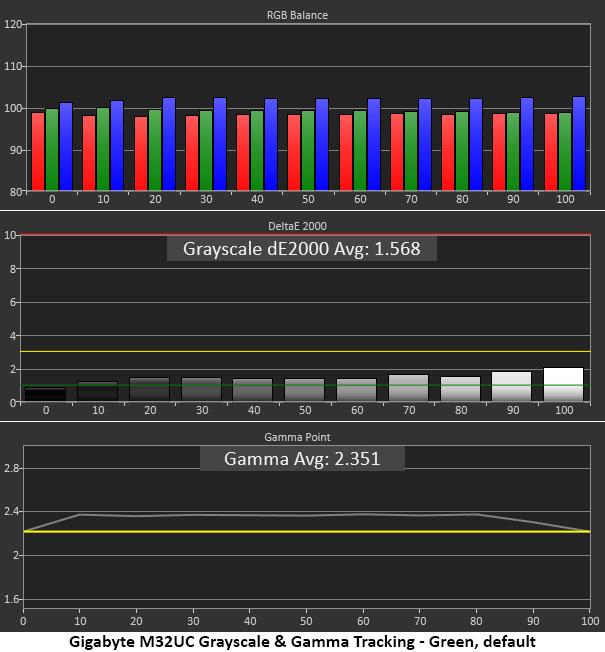
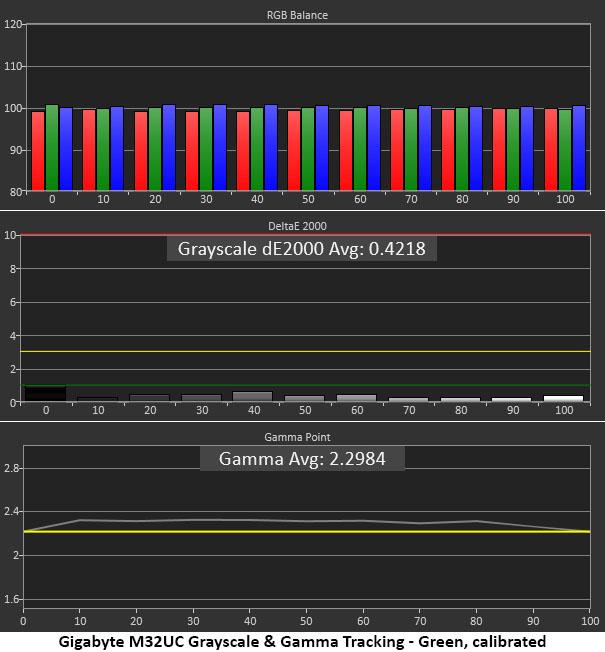
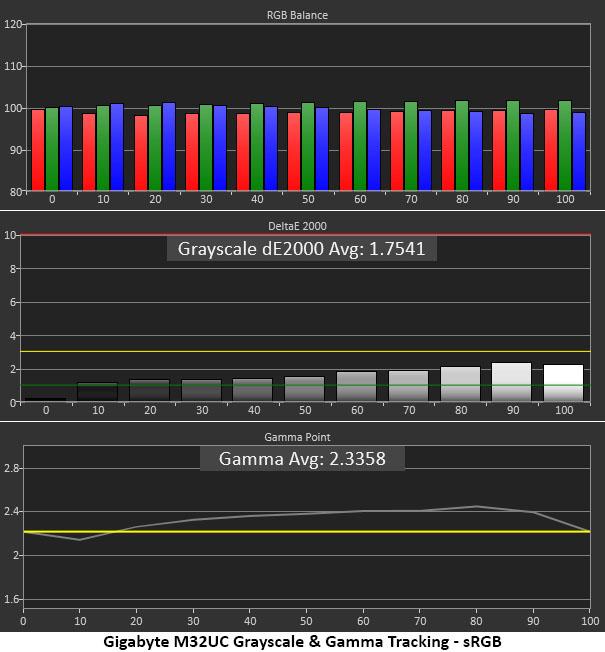
Only the 100% step cracks the 2dE line, which means the M32UC has no visible grayscale errors. 3dE is the generally accepted threshold where color errors can be seen with the naked eye. The gamma runs very tight but, at around 2.35 average, is a little dark. This is excusable for a VA panel due to its high contrast. You can compensate by turning up the brightness a little. If you don’t change the gamma preset, I recommend running at around 220 nits if your room is moderately sunlit like mine. Or you can set gamma to 2.0 and see an actual average of 2.10.
Calibration improves the grayscale measurement though it doesn’t look any different. Gamma is slightly lower, though, which is a good thing.
In the sRGB picture mode, grayscale tracking is equally tight, with all errors well under 3dE. Gamma is a bit wonky with a darker presentation in the mid-tones and highlights. Though this would be the correct color mode for SDR, I preferred to play games in the Green preset using the wide color gamut.
Comparisons

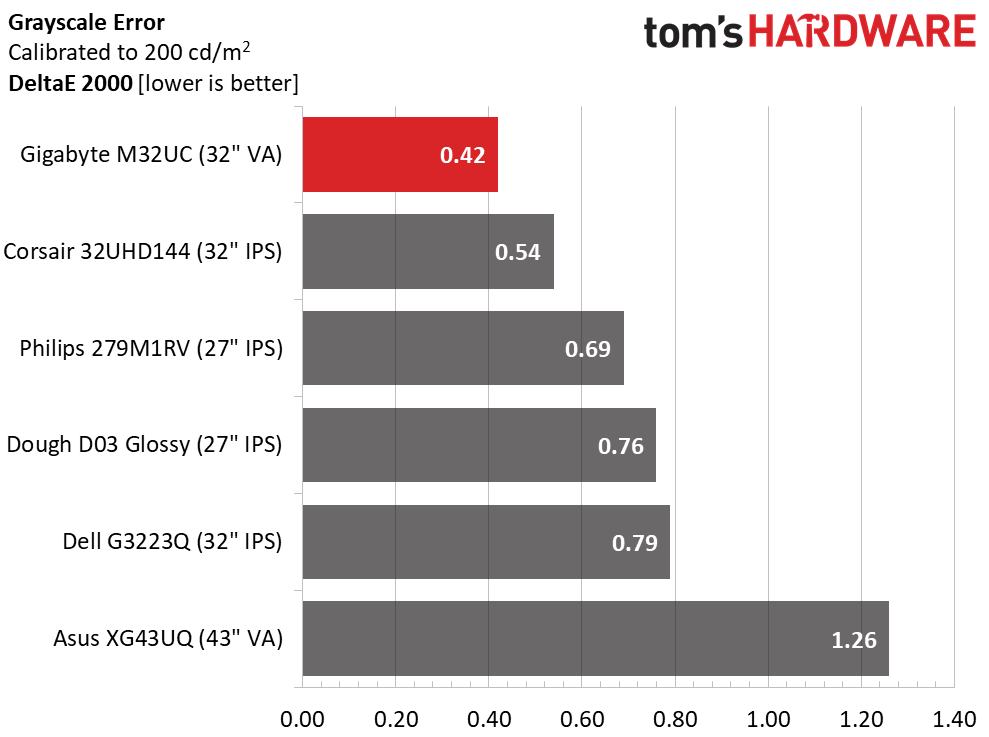
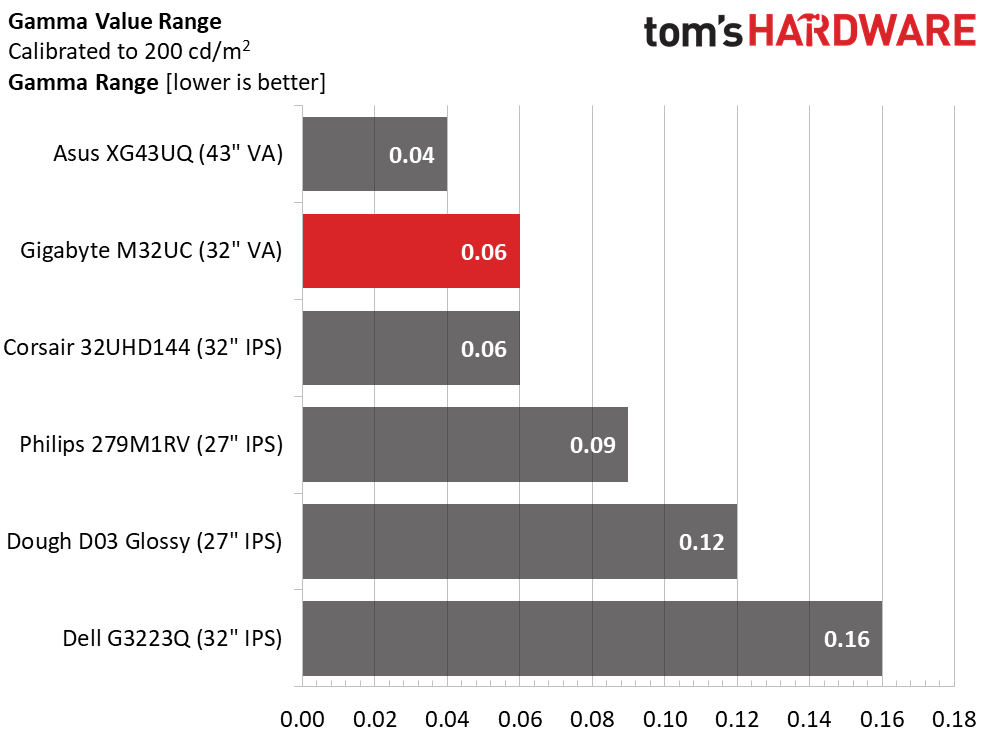
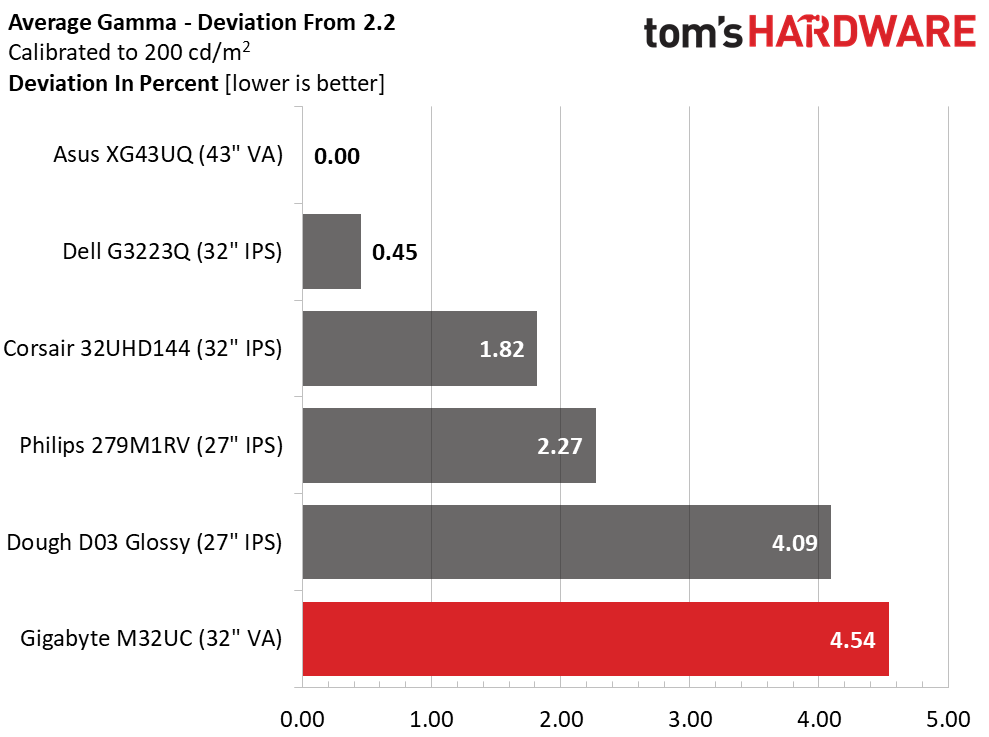
Whether you calibrate the M32UC or not, it presents an excellent image with correct color and gamma close to the reference mark. With no adjustment, it finishes third and after calibration, is the best of the bunch for grayscale tracking. Given the results, there are no bad screens here.
Though the M32UC is furthest from the gamma reference point, its range of values is very low. This keeps all detail fully rendered throughout the brightness range and maintains proper color saturation tracking.
Get Tom's Hardware's best news and in-depth reviews, straight to your inbox.
Color Gamut Accuracy
Our color gamut and volume testing use Portrait Displays’ Calman software. For details on our color gamut testing and volume calculations, click here.


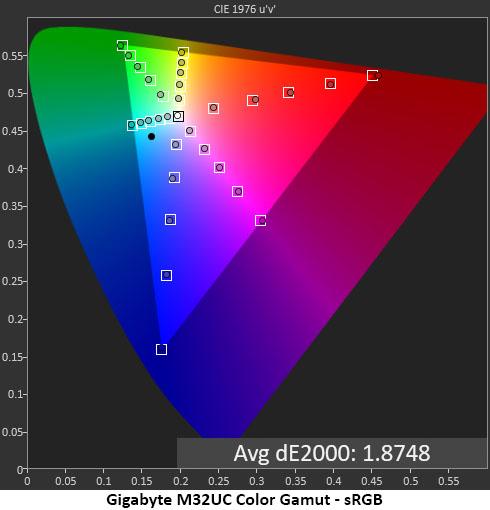
The default color test result for the M32UC is nearly flawless. The only reason for its average 2.46dE error level is the under-saturated green primary. It’s short by around 10%, which is not unusual for wide gamut monitors. The points track in a linear fashion, which is a good thing, and errors are minimal.
Calibration puts the magenta hue points right on target though you won’t be able to see a visual difference here. The numerical gap is too small. Basically, my calibration took the M32UC from great to really great.
The sRGB test result is also excellent, with no visible errors and a low 1.87dE average. Red is the tiniest bit over-saturated, but this is not an issue you’ll see in content. If you need sRGB for a color-critical task, this mode is perfectly usable though I’d recommend using an IEC profile to correct the gamma.
Comparisons
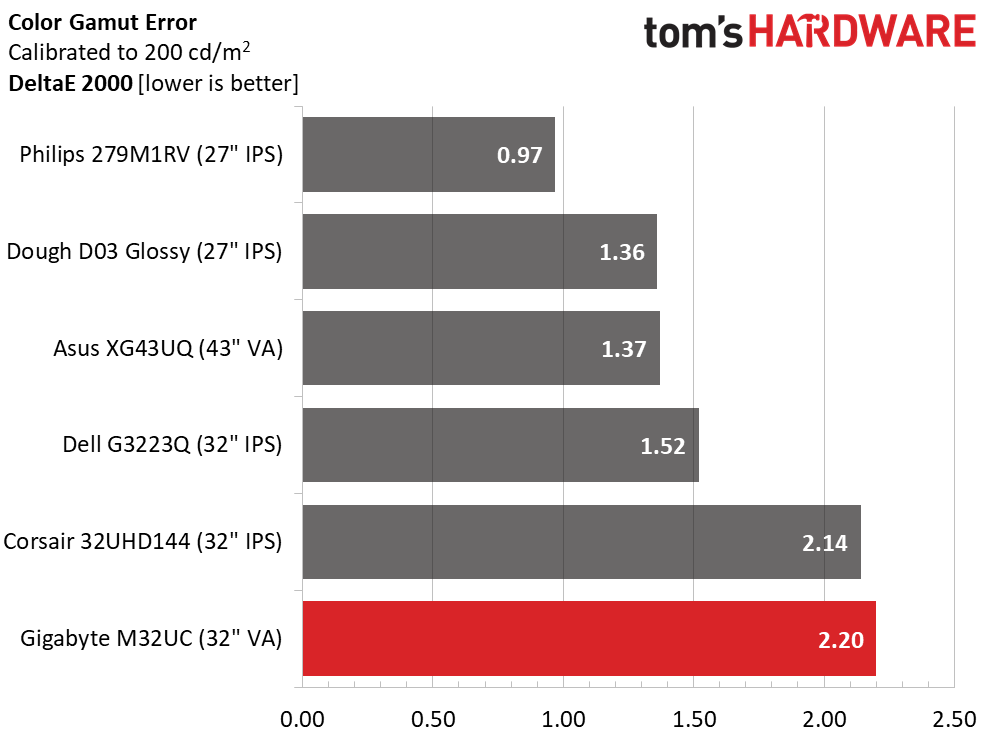
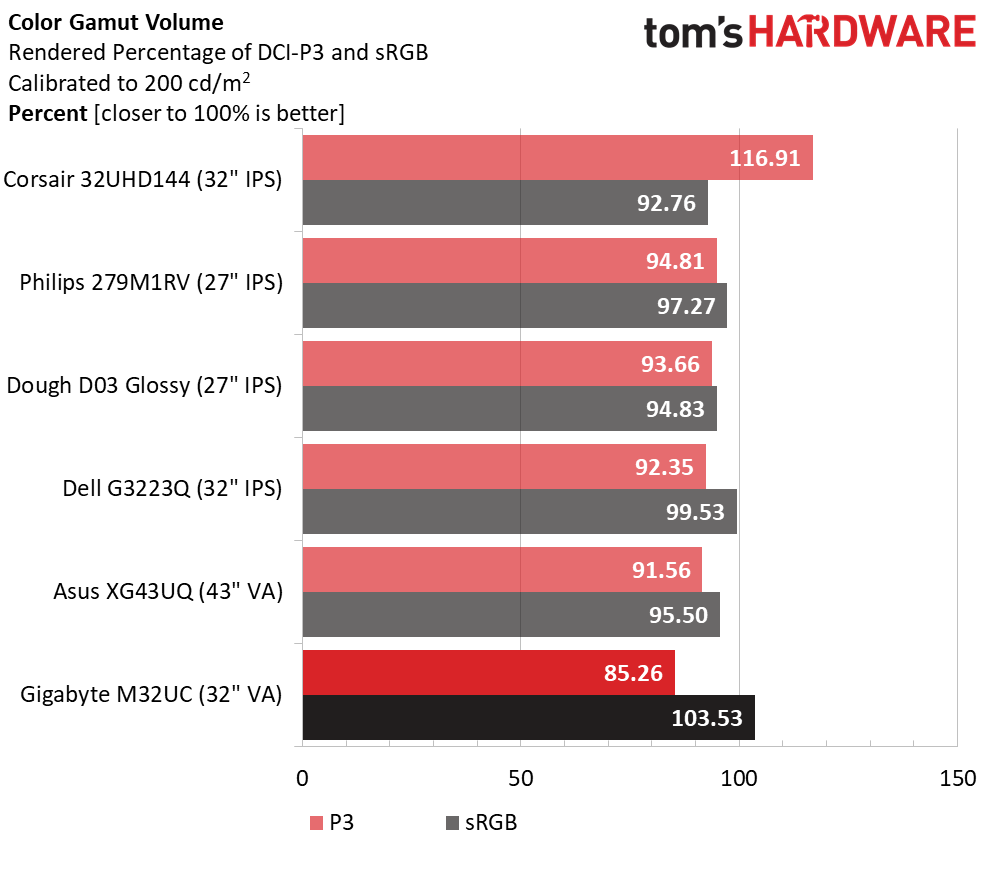
That the M32UC would finish last in a color accuracy comparison with a 2.20dE score speaks to the quality of all these 4K monitors. This is a premium category, and that level of performance is expected. The Gigabyte is a really good deal though at $599. Its price-to-performance ratio is very high.
The M32UC’s only weakness, and it’s a stretch to call it that, is gamut volume. Though 85.26% coverage of DCI-P3 is fine, it’s not as high as many other 4K displays. Green (the primary color, not the picture mode) is the culprit here. The other colors hit their 100% saturation targets. Pictures of grassy fields might not be as lush, but other primary hues will be strong. This is not a deal-breaker by any means. sRGB coverage is a tad over 100%, thanks to some bonus red.
MORE: Best Gaming Monitors
MORE: How We Test PC Monitors
MORE: How to Buy a PC Monitor: A 2022 Guide
MORE: How to Choose the Best HDR Monitor
Current page: Grayscale, Gamma and Color
Prev Page Brightness and Contrast Next Page HDR Performance
Christian Eberle is a Contributing Editor for Tom's Hardware US. He's a veteran reviewer of A/V equipment, specializing in monitors. Christian began his obsession with tech when he built his first PC in 1991, a 286 running DOS 3.0 at a blazing 12MHz. In 2006, he undertook training from the Imaging Science Foundation in video calibration and testing and thus started a passion for precise imaging that persists to this day. He is also a professional musician with a degree from the New England Conservatory as a classical bassoonist which he used to good effect as a performer with the West Point Army Band from 1987 to 2013. He enjoys watching movies and listening to high-end audio in his custom-built home theater and can be seen riding trails near his home on a race-ready ICE VTX recumbent trike. Christian enjoys the endless summer in Florida where he lives with his wife and Chihuahua and plays with orchestras around the state.
-
cknobman You cannot have HDR without any type of local dimming.Reply
Pretty much false advertisement and should make an instant no recommendation IMO. -
Johnpombrio I own the GigabyteM32U which RTratings names as the best 32-inch 4K mid-range gaming monitor with HDR 10, 144 Hz, and IPS for a year and a half now at $650 on Amazon. Going for VA and curved and the hokey HDR 400 sounds like a big step backward.Reply -
truerock VESA DisplayHDR400 is not HDR - in my opinion.Reply
I take Vesa DisplayHDR400 as a VESA definition of a good-non-HDR monitor for a base comparison to the other VESA DisplayHDR standards. It's a helpful marketing tool.
Really, VESA DisplayHDR500 is the lowest level of VESA DispayHDR - in my opinion.
I've been using a 27", 1080P, 8-bit, 60Hz monitor for the last 12 years. When I upgrade, it will probably be to a 32", 4k, 10-bit, 144Hz monitor, VESA Display500 (with NO speakers). -
expert_vision Reply
@truerock I recently got Dell G3223Q for $500 on black firday and I think it meets all your criterias.truerock said:When I upgrade, it will probably be to a 32", 4k, 10-bit, 144Hz monitor, VESA Display500 (with NO speakers). -
truerock Replyexpert_vision said:@truerock I recently got Dell G3223Q for $500 on black firday and I think it meets all your criterias.
Thanks... but, I don't think that monitor is VESA Display500. -
expert_vision Reply
It says it's VESA DisplayHDR™ 600. Is that not better than 500?truerock said:Thanks... but, I don't think that monitor is VESA Display500.
Or are you reffering to the lack of local dimming? In that case, yeah, it lacks.
Personally, I don't care about HDR. I have it disabled and brightness set to 0-10%, lol.